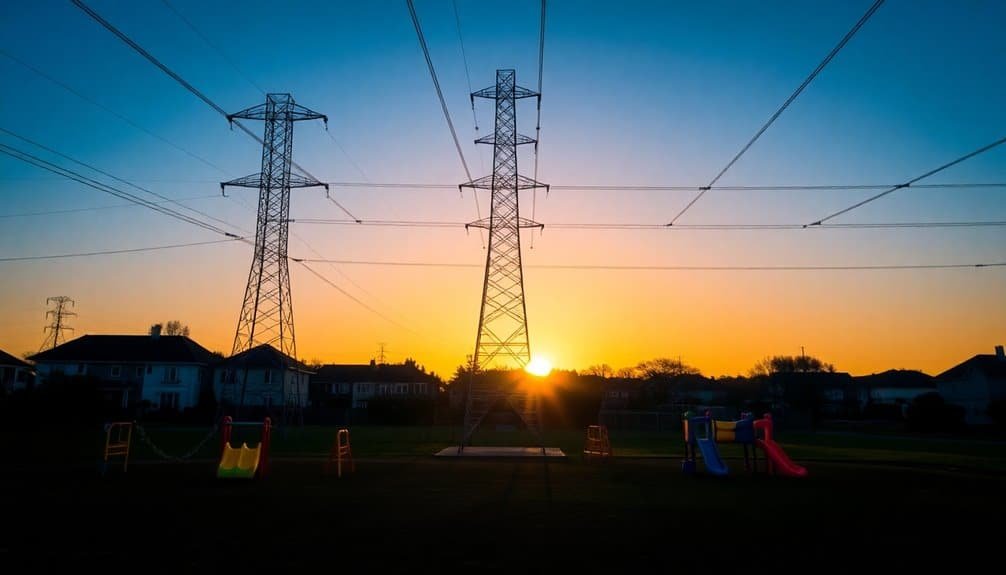EMF and Childhood Leukemia: Examining the Evidence
Epidemiological studies on EMF and childhood leukemia show mixed results, with some suggesting a twofold increase in risk with ELF-MF exposure above 0.4μT while others find no significant link. The IARC classifies ELF-MF as “possibly carcinogenic,” with proposed mechanisms like oxidative stress and DNA damage remaining unconfirmed.
Animal studies also show limited connections, highlighting the need for more research and advanced methods for accurate assessment. Understanding these complexities requires a deeper exploration of the potential biological pathways involved.
Disclaimer: As an affiliate, I may collect a share of sales from the links on this page.
Epidemiologic Evidence Linking EMF to Childhood Leukemia

While the link between electromagnetic fields (EMF) and childhood leukemia has been widely investigated, it remains a topic of considerable debate.
Over 40 epidemiological studies explore this relationship, finding mixed results. Some research indicates a twofold increase in leukemia risk at ELF-MF exposures of 0.4 μT or higher. However, other studies show no association, contributing to uncertainty. The International Agency for Research on Cancer (IARC) classifies ELF-MF as “possibly carcinogenic to humans” based on this mixed evidence. The evidence of association observed primarily reflects statistical correlations, not direct causation, highlighting gaps in understanding the true impact of EMF exposure on childhood leukemia.
Mechanistic Explanations and Biological Effects
Understanding the biological mechanisms behind electromagnetic field (EMF) exposure is essential for evaluating its potential link to childhood leukemia. Proposed mechanisms include oxidative stress, epigenetic changes, and DNA damage, though these aren’t fully confirmed for ELF-EMF.
Exposure to RF-EMF may elevate oxidative stress, leading to reactive oxygen species that can damage cells. Changes in DNA methylation and histone modification can affect gene expression, potentially contributing to disease. Notably, despite the lack of definitive biological pathways, the risk associated with EMF exposure remains a concerning area of study within public health.
Despite these hypotheses, none of the suggested biological pathways for ELF-EMF’s role in childhood leukemia have been conclusively validated, highlighting the need for further research to clarify these complex interactions.
Insights From Animal Studies

Animal studies haven’t provided strong evidence that electromagnetic field (EMF) exposure causes leukemia or lymphoma. Research involving rodents consistently fails to demonstrate a carcinogenic link.
The biological functions of cells can mask EMF’s potential effects, categorized as “biological noise.” Although animal models follow the multistep pathogenesis of acute leukemia, EMFs don’t align well within this model. Electric fields exist regardless of device status, which complicates the ability to isolate their impacts.
Current exposure levels in studies are often unrealistic compared to human scenarios. A lack of mechanistic understanding hinders our insight into EMFs’ role in cancer. Consequently, the relevance of these findings to human health remains uncertain and calls for further exploration.
Regulatory Perspectives and Public Health Implications
As concerns about electromagnetic field (EMF) exposure grow, regulators and public health officials are examining the implications for childhood leukemia.
Currently, no federal US standards exist for EMF, but international guidelines, like those from ICNIRP, set safe exposure limits. Authorities like the EPA and NIEHS assess EMF risks, while the WHO evaluates potential health effects.
Public anxiety is rising as studies suggest even low levels of EMF can pose risks for children.
- Children’s health is at stake
- Families deserve clear guidelines
- Precaution is essential for safety
- Awareness must increase for protection
Directions for Future Research

Research into the relationship between electromagnetic field (EMF) exposure and childhood leukemia requires a multifaceted approach. Future studies should prioritize large-scale epidemiological research, including diverse populations and multiple exposure scenarios.
Longitudinal studies can track EMF exposure over time to assess leukemia risk. Experimentally, scientists should explore biological mechanisms through cellular and animal studies, investigating how EMFs interact with genetic factors.
Improving exposure assessment is crucial; accurate measurement tools and wearable monitors can refine assessments. Advanced statistical techniques and machine learning models will facilitate data analysis, enabling clearer insights into any potential dose-response relationships and guiding effective policy and safety regulations.
Frequently Asked Questions
What Are Electromagnetic Fields (EMFS) and Where Do They Come From?
Electromagnetic fields (EMFs) are invisible areas of energy generated by electric charges. They come from various sources, including power lines, home appliances, and office equipment, as well as natural occurrences like sunlight and cosmic radiation.
How Can I Reduce My Child’s EMF Exposure at Home?
To reduce your child’s EMF exposure at home, keep devices out of bedrooms, encourage outdoor play, and use wired alternatives for headphones. Checking for hidden sources and creating device-free zones can also help greatly.
Are There Specific Symptoms Related to EMF Exposure in Children?
Yes, you might notice symptoms like headaches, sleep disruption, or fatigue in your child due to EMF exposure. Some kids also report cognitive issues, like trouble concentrating or mood changes, which can be concerning.
What Is the General Public Perception of EMF Exposure Risks?
Did you know only about 30% of people actively worry about EMF exposure? Generally, you might find misconceptions outweighing real risks, as public concern remains low compared to other environmental hazards. Increased education can help clarify perceptions.
How Do Different Countries Regulate EMF Exposure Levels?
Different countries regulate EMF exposure levels through various guidelines, often based on EU recommendations or WHO standards. You’ll find stricter limits in some nations due to public health concerns and varying safety standards.
Conclusion
Studies suggest a potential link between electromagnetic fields (EMF) and childhood leukemia, especially in high-exposure areas. Research indicates children near high voltage power lines may face a 2.5 times greater risk of leukemia than those further away. While biological mechanisms are still being studied, these findings call for careful consideration. Public health guidelines should adapt as research progresses, and ongoing studies will clarify these connections for future safety regulations.






